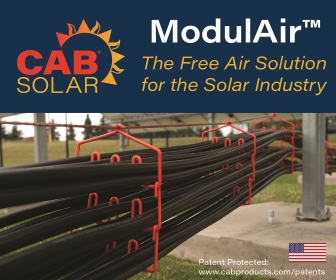Your Comprehensive Guide to Solar Cable Requirements
No matter where you’ve seen them — buildings, agricultural facilities, open spaces, even floating on the surface of water — all photovoltaic systems use special solar cables to interconnect the individual modules with each other, as well as with the inverter and other components.
Photovoltaic systems consist of a multitude of individual modules that convert solar energy into direct current (DC). In order to make it usable, the individual modules are connected in parallel or in series using cables designed to carry direct current. The same applies to the cable that connects the photovoltaic modules to the inverter. This device converts the generated direct current into grid-compatible alternating current (AC).

How are solar cables structured?
Previously, the requirements for solar cables were defined in the PV1-F standard. Acceptable conductors were identified with the respective abbreviation. Since 2015, the updated standard – EN 50618 – has been in effect. Suitable solar cables are now labeled as "H1Z2Z2-K". This imprint guarantees the cable possesses all the necessary characteristics for use in photovoltaic systems. For the U.S. market, the 2023 edition of the NEC (National Electrical Code) developed Article 690 - Solar Photovoltaic (PV) Systems to provide guidance on electrical energy systems, array circuits, inverters, and charge controllers for PV systems. The NEC is commonly used in the United States for various installations (local codes may still apply). PV cables must also be approved under UL Standard 4703, while c(UL) or CSA 22.2 No. 271 must be obtained for use in Canada.
Solar cables are typically single conductors with a finely stranded, tinned copper wire. For both the conductor insulation and the outer jacket, specialized polymers have proven to be effective, as they offer superior properties compared to rubber or PVC, particularly in terms of durability. Depending on the plastic composition, the cables are suitable for various applications, including outdoor use and underground installation. The cross section of a solar cable should typically be a minimum of AWG12 (4 mm²). The cables are available with cross sections of up to 500 kcmil (240 mm²). It is crucial to select appropriate cross sections for optimal power generation carefully.
What requirements must solar cables meet?
Depending on where they are deployed in the field, photovoltaic systems are exposed to high and low temperatures, various weather conditions, humidity, chemicals, and (of course) solar radiation. Despite these challenging environmental conditions, they must function reliably for extended periods as manufacturers and operators plan for a system lifespan of 20 to 30 years. Accordingly, all installed components must meet high standards –this applies to the wiring as well.
According to EN 50618, solar cables should possess the following characteristics:
- Weather, UV, and ozone resistant
Wind, weather, and the UV radiation of sunlight accelerate the aging of cables. Solar cables must therefore comply with the standards of DIN VDE 0283-618 and DIN EN 50618.
- Temperature resistant
When used outdoors, the cables may be exposed to extreme heat or cold. Therefore, solar cables are designed for a temperature range of -40°C to +90°C.
- Flame retardant and halogen-free
In the event a photovoltaic system experiences a fire, it is crucial that the cables used are highly flame-resistant and do not emit toxic gases when burning. Solar cables are therefore halogen-free according to DIN VDE 0482-754-1 / DIN EN 60754-1 / IEC 60754-1 and flame-retardant according to DIN VDE 0482-332-1-2 / DIN EN 60332-1-2 / IEC 60332-1-2. Other flame tests that can be passed are VW-1 in the U.S. and FT1 in Canada.
- Dielectric strength
The direct current in photovoltaic systems can exceed 1,000 volts. Solar cables possess an exceptional level of voltage resistance. The test criteria for this are defined in DIN VDE 0283-618 / DIN EN 50618 Table 2.
For specialized applications, such as in agriculture, outdoor environments, or on water, solar cables with specific characteristics are available. These characteristics include:
- Mechanical strength
Even though solar cables are rarely moved in the field, they need to be resistant to abrasion and other mechanical stresses for long-term operation.
- Acid and alkali resistant
In the agricultural sector, solar cables may be exposed to ammonia, oxalic acid, caustic soda, or other chemicals. Therefore, the outer jacket must be acid- and alkali-resistant according to EN 60811-2-1.
- Rodent protection
Mice, rats, and other rodents can damage a photovoltaic system’s cables, which can lead to disruptions and outages. To prevent this, solar cables are also available as a special variant with a specific rodent protection feature consisting of a braided stainless-steel mesh that is placed around the exterior of the cable.
- Floating PV certification
For floating photovoltaic systems, also known as floating farms, specific testing regulations apply under TÜV 2 PfG 2750. Therefore, cables used in these installations should be appropriately certified.
 Summary
Summary
Although solar cables are relatively simple in structure, they must meet high standards to satisfy diverse requirements. Simultaneously, they should ensure the reliable operation of the photovoltaic system for approximately 20 to 30 years. Therefore, it is crucial that the cables used are made of high-quality materials and manufactured properly to comply with all applicable standards and regulations.
Michael Thomczyk is Key Account Manager Utilities & PV/Solar at HELUKABEL, a single-source supplier for the cables, wires, and accessories that run industry and infrastructure worldwide.
HELUKABEL | www.helukabel.us
Author: Michael Thomczyk
Volume: 2024 September/October











.png?r=6796)
